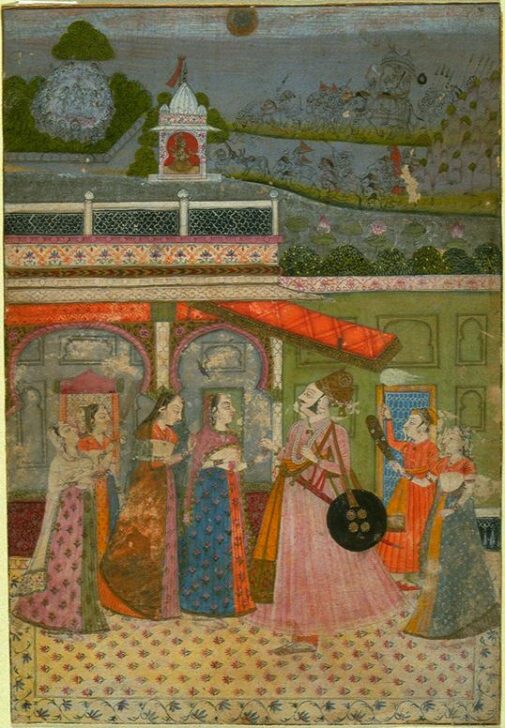A Raja with his Ladies
Indian

Description
The artist of this painting was a master of subtlety in his choice of pale colors and the way he has combined multiple themes. The main scene in the foreground is of a king with his ladies standing somewhat stiffly in a palace courtyard. His sword and shield identify this image as a royal portrait and not a scene of dalliance. Even the architecture fits this formal purpose, with its geometric regularity. Beyond the palace walls, however, a very different mood prevails. Geometry gives way to organic shapes, and forms are only half-visible under the night sky. At the upper right, a royal procession (note the howdahs on the elephants) is en route to a small Devi shrine, the marble structure that glows in the moonlight. (The moon, almost directly over the shrine, was painted in silver that has oxidized.) At an even greater distance, we catch a glimpse of Krishna, surrounded by adoring gopis (cowgirls), in the forest. His dance and dalliance with them is known as Krishnalila—the “play of Krishna.”
The patron thus has himself presented as both a dignified military commander who presides over a cultured household and a custodian of local sites dedicated to the gods.
Exhibited in "Divine Encounters, Earthly Pleasures: Twenty Centuries of Indian Art" at UMMA, 12/12/03–2/22/04.
Subject Matter:
The main scene in the foreground is of a king with his ladies standing somewhat stiffly in a palace courtyard. His sword and shield identify this image as a royal portrait and not a scene of dalliance. Even the architecture fits this formal purpose, with its geometric regularity. Beyond the palace walls, however, a very different mood prevails. Geometry gives way to organic shapes, and forms are only half-visible under the night sky. At the upper right, a royal procession (note the howdahs on the elephants) is en route to a small Devi shrine, the marble structure that glows in the moonlight. (The moon, almost directly over the shrine, was painted in silver that has oxidized.) At an even greater distance, we catch a glimpse of Krishna, surrounded by adoring gopis (cowgirls), in the forest. His dance and dalliance with them is known as Krishnalila—the “play of Krishna.”
The patron thus has himself presented as both a dignified military commander who presides over a cultured household and a custodian of local sites dedicated to the gods.
Physical Description:
The painting is divided into two panels. The lower panel depicts the Raja with six females in the courtyard of a palace. The Raja stands with a sword and shield. The palace is decorated colorfully, which contrasts with the upper panel which is monochromatic blue. The upper panel depicts a procession scene, which includes figures on horses and an elephant as well as a shrine.
Usage Rights:
If you are interested in using an image for a publication, please visit https://umma.umich.edu/request-image/ for more information and to fill out the online Image Rights and Reproductions Request Form.